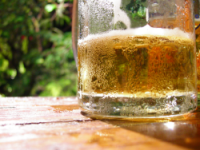There are basically four phases in brewing beer, each phase broken down into smaller steps, but it is important to remember to follow the steps, especially of any custom recipe with patience and precision or your beer will not turn out as you might hope. We will go over the process for cooking or brewing your beer using the cheat of malt extract. You can make your own mashed malt, and I will discuss this in a future article, but for now, we'll keep things simple at first just to practice the procedure of making beer, and getting the experience of our first batch under way.
NOTE: Start your training and continue your beer making hobby with copious note taking. Write down everything. Write down the date and time you perform each task. Write the amounts of each ingredient down.
Start with a simple beer first, here is a sample...
Amber Ale
8# pale malt extract
1# 60L Crystal
1/2 # Carapils
1 oz Challenger (7.9%) 60 min
1 oz Challenger 5 min
Ferment with W.L. California Ale Yeast
If you bought a beer making kit, you will want to follow the specific instructions provided with the kit. Otherwise, read on my eager fellow beer maker.
Starting with sterilized 20 quart boiling pot, stirring spoon (2 foot steel spoon), tablespoon, pyrex measuring cup, mason jar, thermometer, and five gallon glass primary fermenting container or plastic carboy and an airlock for your fermenting container. These parts can all be sterilized by either boiling for 20 minutes, or using a bleach based bath to soak these items for 20 minutes. If you use a sanitizing product, be sure to rinse these parts thoroughly with clean/boiled water before use. Also, use a good hand sanitizer for your hands before touching anything. You need to ensure the surfaces which touch your beer, yeast, grains or water is sterile at all times, so be careful what you touch and try to maintain some awareness to your kit.
All great brews start with great tasting water. If your water is not of good quality, you can use bottled water, but you will typically start with 1.5 Gallons of water for your first batch. Other recipes may call for more water, and that's OK too, just watch your recipe for details.
NOTE: Keep a gallon or so of warm pre-boiled water on hand for a number of tasks, including re-hydrating the yeast, rinsing utensils, and cleaning later.
We're now going to make wort (wurt). This is the basis for your beer. Bring 1.5 gallons of water to a boil in the 20 quart pot on your stove.
While your water is heating, it's time to rehydrate the brewers yeast. The yeast selected is important to the taste of your beer and must you must be very careful to do this with viable yeast and keep the temperatures within the specified tolerance levels or it will either not ferment or will die from too much heat. So...Put 1 cup of warm (95-105°F, 35-40°C), pre-boiled water into your sanitized jar and stir in the yeast. Cover with plastic wrap and wait 15 minutes.
Proofing the yeast is required to ensure the yeast is alive. This is done by boiling 1/4 cup of water and adding 1 teaspoon of malt extract, which is set aside to cool. Once cool, you can pour it into your yeast jar and observe for any activity, churning or foaming action. If nothing happens, your yeast is dead and you should try these steps again with fresh yeast and keeping an eye on your temperatures.
Once your water is boiling, it is time to add the malt extract. Turn off the burner before adding the malt extract, to prevent sudden boil overs. Gently stir the malt into your water to ensure a complete mixing of malt and water. Once you are convinced the malt is completely dissolved, add your hops and turn the burner back on to bring the wort to a boil. Continue stirring your wort to prevent boil overs for one hour (unless your recipe calls for less or more time). Unhopped malts may require more boil time than hopped malts.
Take the wort off the burner and cool to a yeast pitching temperature (65-90 °F [18-32 °C]) by placing the boiling pot into a tub of ice water. You want to prepare the wort for the yeast, without killing the yeast in the process.
NOTE: Sanitize your fermentation bucket or carboy, strainer, air lock, and siphon before continuing.
We are now ready to start the fermentation process. Fermentation is the the conversion of carbohydrates into alcohols or acids under anaerobic conditions used for making certain foods. Fermentation begins when we Pitch the yeast into the wort. Pour your yeast solution into the fermentation bucket/carboy followed by the wort. Take care to pour the wort into the fermentation container through a strainer to catch any hops and top help aerate the yeast.
Find a warm 65-70 °F (18-21 °C), temperature and light stable environment for storing your fermentation bucket, then seal the container. The airlock should be firmly in place and you will begin to see evidence of fermentation within 24-48 hours. Allow the fermentation to continue for a minimum of two weeks or longer depending upon your tastes and ingredients. The sugars need to be completely fermented, and particles in your wort must settle to clear the mixture. The more time you allow at this phase, the clearer your beer will be, but a cloudy beer does not mean bad tasting brew. Experiment with various durations of fermentation after this batch.
Finally, thoroughly clean and sterilize all of your cooking utensils, pots, and other equipment, and stove.
Go have a beer, you deserve it. You'll get to sample your own soon enough.




![[Social Submit this] [Social Submit this]](http://www.socialsubmit.com/images/socialsubmit.png)
![[Social Poster] [Submit this to Social Poster]](http://socialposter.com/spl3.gif)